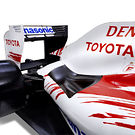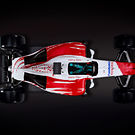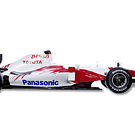Q+A with Pascal Vasselon

Panasonic Toyota F1 have today unveiled their new TF109, the car that will compete in the Formula One 2009 championship. As the 2009 regulations have drastically changed, the new Toyota F1 car looks completely different than its predecessor. Pascal Vasselon, Toyota's Senior General Manager Chassis, gives us more insight in the new machine
"It is hard to make a clear prediction of how we will perform before we have been able to measure the car's performance against our rivals on track. However, our obvious intention is to fight for Toyota's first Grand Prix victory. We will fight to do this in 2009 but in addition we want to finish on the podium more often and break into the top three in the championship. This will not be easy and we have learned that Formula 1 is never easy, but we like to set ourselves high targets and I believe we have the potential to achieve them. Last year we returned to the podium and the front row of the grid, so the positive momentum is there and we must now take advantage of the opportunity presented by such a major regulation change."
Can you give an idea of how much work has gone into the TF109?"We have worked to the maximum of our capabilities as we always do but this time it had to be special because the rule changes were so big that we had to reconsider everything. So this complete programme has been more demanding on our company than any previous new car project I have been involved in. It started earlier than ever before; as soon as the 2008 regulations were finalised in October 2007 we immediately started to work on the TF109 programme. We had an early start with significantly more resources dedicated to the new car development during the year than in previous seasons. During the season we were developing the TF109 in parallel with the TF108."
How did you balance development of the TF108 and TF109?"Naturally it was a challenge all year long but I think we managed it very well. We made significant improvements to the TF108 throughout the year without ever compromising the TF109. We decided on the development schedule last winter and we have been able to stick to it, which is a credit to everyone involved. Throughout 2008 we had a lot of our resources focused on developing the TF109 and I hope we will see the benefit of that commitment"
What characteristics are you hoping for in the TF109?"That it is quick! Of course that is our priority. In order to be competitive we will be looking for stability and wide working window, as we were when we developed the TF108. For last year's car we targeted stability because the analysis of the shortcomings of the TF107 was that we were lacking stability and driveability, so we made a big effort on those areas for the TF108. Now for 2009 we will still put a lot of emphasis on stability but for different reasons. We expect top speeds to be similar and sometimes even faster this year but there will be less downforce; this makes stability very important. We also expect the slick tyres to generate a different front and rear grip ratio which will affect stability so that is one of the primary goals for the TF109."
How big a challenge is it to adapt to the regulation change?"Obviously it has been a significant challenge because it was a very large regulation change, the biggest one since 1998 and the track width change. But I have to say it has been a really interesting and exciting experience, especially given our team's situation. We are still a young team in Formula 1 terms and we have been playing catch-up with other teams who were more experienced in dealing with the previous regulations. Now, with these new regulations, all teams are starting from scratch. We have given full freedom to the creativity of our team members, without imposing any restrictions, and the results have been really rewarding."
How much less downforce will the 2009 cars have compared to last year?"The target of the regulations was to reduce downforce by 50% on the levels we had at the time, in 2006. But since then everyone has been working hard on ways to recover the downforce; that is our job as engineers! We have recovered part of the lost downforce, not all of it by any stretch, but we have been making strong progress. Of course, as soon as we begin running the new cars on the track you can expect all teams to make more downforce gains. It is difficult to say exactly where we will end up but we will have considerably less downforce than in 2008; that is clear."
So does that mean the cars will be slower? By how much?"That is a difficult question because of the combination of many unknown factors. However, it is reasonable to predict that the 2009 cars will not be a lot slower than their predecessors. We have lost some downforce, but not as much as the original 50% figure for the simple reason that teams employ very talented people to recover this downforce. But in addition to the aerodynamic regulations, you have to consider the slick tyres, which will make the new cars faster in slow to medium speed corners thanks to better grip. So, to put it simply, we will lose some speed due to the aerodynamic regulations but we will gain some with the slicks. All in all the 2009 cars will not be significantly slower than they were in 2008."
Will it be harder to find an ideal set-up for each circuit this year, considering the number of changes?"Of course, it will be a big challenge to find the set-up sweet spot because with the bodywork changes and the move to slick tyres, we are looking at a wider set-up window this year. Due a period of relatively stable regulations, in recent years it has been quite straightforward to define a narrow set-up window at each circuit. Now we have to make that set-up window wider to take into account that there are more elements which we are still learning about. One of our main tasks in pre-season testing will be to gather the information necessary to narrow this set-up window but there is no doubt we will be even busier this year in practice at each Grand Prix, defining the right set-up."
Source Toyota






